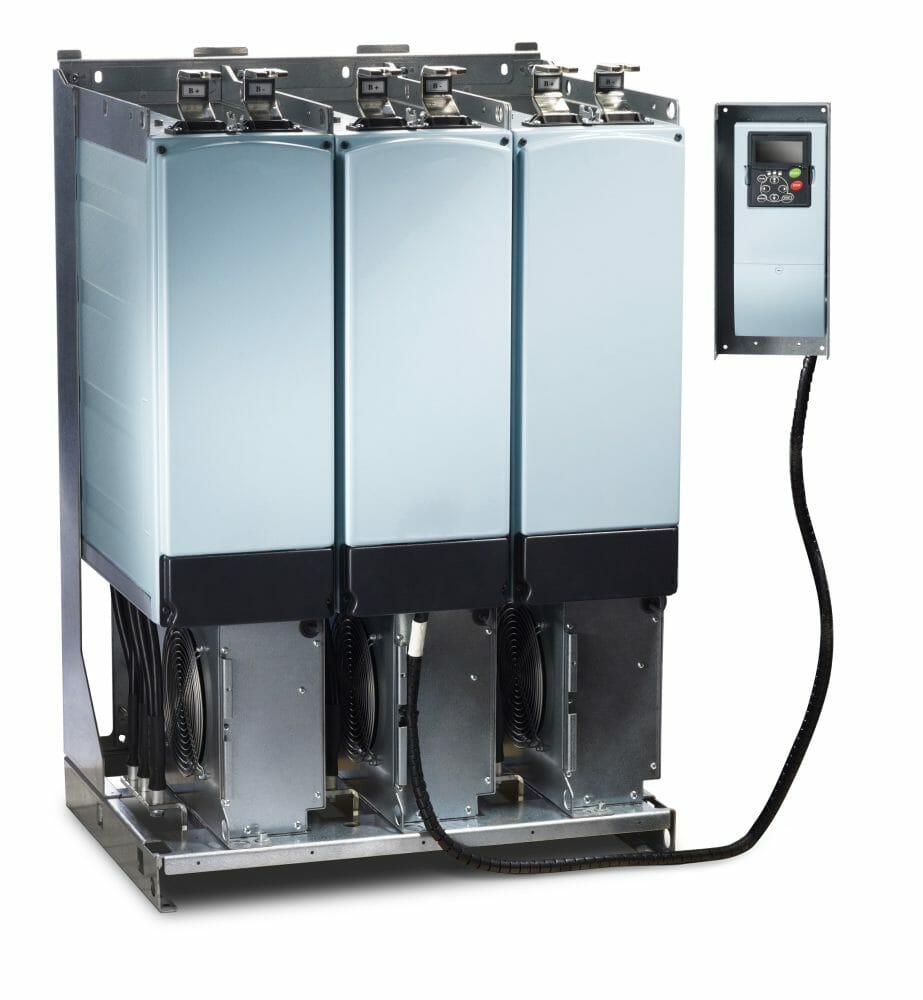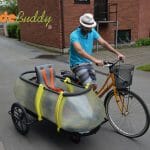Modern drive system from frequency converters with regenerative braking helps save energy in the test laboratory
Testing low voltage switchgear equipment and electric power systems are the core competencies of the Institute for International Product Safety GmbH (I²PS GmbH) test facility in Bonn, Germany. This location boasts one of the world’s most efficient surge generator systems. During the modernisation of this system, the company decided to renew the available drive of the excitation generator. This was achieved by using an asynchronous motor with frequency converter technology from Eaton. The result increased the energy efficiency of the system, as well as its flexibility.
Background
The Institute for International Product Safety GmbH (I²PS GmbH) carries out tests and trials in the electrical engineering, electronics and environmental specification fields in accordance with national and international standards. Based in Bonn, Germany, the test laboratory uses the most modern testing equipment and measurement techniques and holds DIN EN ISO/IEC 17025 accreditation. Testing services include the areas of industrial low voltage devices and systems, the safety of electrical equipment and electromagnetic compatibility (EMC), as well as environmental tests. The testing of equipment for low voltage technology with short-circuit and internal arc tests with currents up to 300 kA are also included in the services.
The high energy required for the experiments is provided by a surge generator with a separate excitation system. A special control device allows the adjustment of the impulse excitation generated by the exciter, even during short-circuits. In this way, a constant short-circuit current is available with short current flow times in the range of 100 ms and with longer current flow times up to a few seconds. This makes it possible to reproduce the short circuit conditions required by the standards to test the generator or transformer.
Challenge
The exciter of the surge generator was driven by a slip ring motor with oil-cooled starting resistors. These oil-cooled resistors heat up markedly during start-up; similarly, when the motor decelerates, the braking energy heats up the oil. Before restarting the motor, the machine operator had to wait a while to allow the oil to cool down. To save this time, often the surge generator was kept running during longer conversion phases of the experimental set-up. However, this wasted a lot of energy. On top of this, the slip ring rotor motor was already over 40 years old; so the maintenance and procurement of the necessary spare parts were becoming more difficult and very expensive.
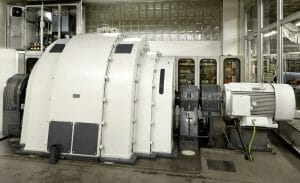
The Surge Generator: in the test laboratory of I²PS GmbH, right, the new asynchronous motor, left behind the open switching cabinet with the Eaton drive solution.
For these reasons, I²PS was on the search for a modern drive solution. It was determined that the new system must fulfil the following criteria: it should function reliably, be energy efficient and allow restarts without long waits. Moreover, in the event of a breakdown or malfunction, a sufficient repair service level must be provided by the supplier.
Solution
Against this background I²PS developed, in collaboration with Eaton, a solution that replaces the slip ring motor with an asynchronous one. This is driven by an electronic drive unit consisting of a frequency converter and regenerative braking unit (AFE, Active Front End).
Both components belong to Eaton’s 9000X series; this extensive range of DC bus drives includes several regenerative units and frequency converters with power ratings from 0.55 to 2,750 kW at 460 and 690 V. They follow a modular compact design concept and providing versatile features, including quick start, flexible communication and extensive configuration options. Five slots are available for optional I/O and communication cards to accommodate customer-specific requirements. Various communication protocols are supported to allow connection to a wide range of automation systems based on Modbus/TCP, Modbus/RTU, Profibus DP and Ethernet/IP. In addition, the modular separation of the power and control units simplifies installation and reduces the need for spare parts.
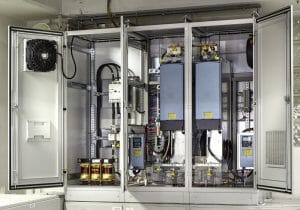
Frequency Converter: The air cooled frequency converter (SPI) with the regenerative unit (SPA) of Eaton saves braking energy of the motor back into the grid
In the case of the I²PS solution, the SPI300A0-4A3N1 inverter unit and the air-cooled regenerative SPA300A0-4A3N1 unit are used. The AFE SPA is a bi-directional voltage converter for the front-end of a common DC bus. It converts alternating current or voltage in direct current or voltage. The power is transmitted from the grid into the DC bus or vice versa.
When used on the exciter of the surge generator, the Eaton-Regenerative unit supplies the kinetic energy that is released during braking back into the grid. Previously, when the exciter was shut down it came to a complete standstill after about 30 minutes; with the SPA-regenerative unit, however standstill is reached within two minutes. Equally, from a standstill, it’s back up to normal speed within two minutes.
The upstream LCL (inductance-capacitance-inductance) filter corrects any waveform distortions on the output voltage, thus producing clean power with low harmonics that is suitable to be returned to grid. The Total Harmonic Distortion (THD) is below 5%. For comparison, normal six-pulse frequency converters have a THD of approximately 35 – 40%. With power regeneration, the system does not need large oil-filled resistor banks for removing excess energy. Eliminating the resistors increases energy savings while simplifying design.
Theoretically, a braking chopper can be used as an alternative to speed up the deceleration of the exciter. However, this would convert the kinetic energy into dissipated heat again. This type of braking system would be generously sized and therefore requires a lot of space. By contrast, the solution favoured by I²PS is not only more energy efficient, but also more space saving than this quite common, but significantly more complex technology.
The SPI inverter used is a bi-directional DC-fed drive for controlling AC motors. The inverter has a DC bus coupling and also allows the user also the regenerative operation of a drive system. In this manner, the braking energy of the drives can be directly transmitted to a motor driven drive via an intermediate circuit coupler or, as in the case of I²PS, fed back into the grid. As with the regenerative unit the air cooled inverter also uses IGBT technology as well as an alphanumeric keypad and corresponds to the EMC class T (EN 61800-3 for IT networks), as well as the safety standards CE/UL.
Results
The upgraded drive system of the exciter is now part of a surge generator plant with a peak short-circuit power of 298 MVA. Short circuit tests for in the low voltage range with test currents up to 300 kA are therefore possible. In the case of lengthy test setups, it’s now possible to stop the surge generator to save energy, without losing time. Before modernisation, this was only possible a maximum of three times a day due to the oil-cooled starting or braking resistors. The necessary cooling phases required for the intensely heated oil are eliminated thanks to the new drive solution. The braking energy of the exciter motor is now fed back to the grid. Therefore, the system can be stopped easily in the case of time-consuming conversion work of the experimental set up, and then quickly restarted. In parallel, the flexibility of the testing laboratory has increased.
Klaus Heidelberg, manager Energy/Switching Power, I²PS, drew the following conclusion: “The ability to stop and start the surge generator as and when needed, is a decisive advantage of the modernisation for us. Moreover, the new drive solution is much more energy efficient than the old slip ring motor. The total energy saving is thus achieved in three ways – the energy efficient drive system, the energy saved by switching off the surge generator during set up and the return feed of the braking energy into the grid, which was previously lost in the form of heat. In addition, the Eaton customer service provided during the installation and commissioning phases was indispensable.”
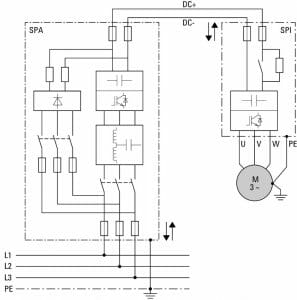
Flexible System Configuration: for lower upper oscillations: a range of SPI inverters can be connected to the respective motor via the SPA regenerative unit.
About Eaton
Eaton’s electrical business is a global leader with expertise in power distribution and circuit protection; backup power protection; control and automation; lighting and security; structural solutions and wiring devices; solutions for harsh and hazardous environments; and engineering services. Eaton is positioned through its global solutions to answer today’s most critical electrical power management challenges.
Eaton is a power management company with 2016 sales of $20.9 billion. Eaton provides energy-efficient solutions that help our customers effectively manage electrical, hydraulic and mechanical power more efficiently, safely and sustainably. Eaton has approximately 95,000 employees and sells products to customers in more than 175 countries. For more information, visit www.eaton.com .

